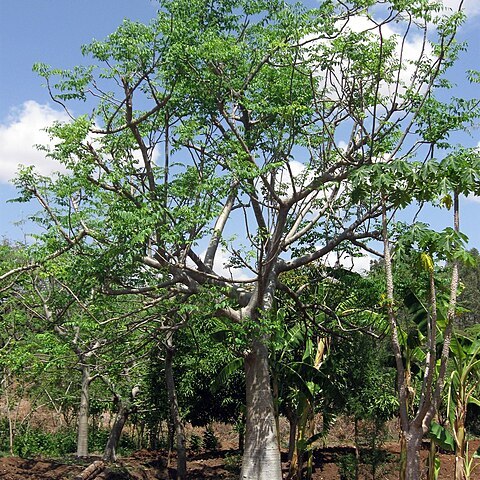Tree 6-10 m. tall, ± 60 cm. diameter at breast height, with strongly branched crown, sometimes with several trunks, ± thick at base; bark white to pale grey, black or silvery, smooth; wood soft; branches with leaf-scars 6-10 mm. diameter; young stems and leaves densely velvety pubescent.. Leaves up to 55 cm. long, 2-± 3-pinnate with ± 5 pairs of pinnae and 3-9 leaflets per pinna; leaflets elliptic to ovate, 3.3-6.5 cm. long, 1.8-3.3 cm. wide, acute, with thickened apiculum at apex, rounded to cuneate at the base, pubescent or ± glabrous; petiole 10-15 mm.; stipel-like glands clavate ± 2 mm. long.. Flowers strongly scented in pubescent dense many-flowered panicles ± 60 cm. long, regular, hypogynous; peduncles 4-10 cm. long; stalks ± 2 mm. long; true pedicels almost obsolete or 0.5 mm. long; receptacle small 1 × 2 mm.. Sepals cream flushed pink, subequal, oblong-elliptic, 4-7 mm. long, 2-3.5 mm. wide, ± obtuse, glabrous save for ciliolate margins.. Petals white, pale yellow or yellow-green, linear-oblong to oblong, slightly spathulate, 8-10 mm. long, 1.5-2.5 mm. wide, with long multicellular hairs inside.. Filaments white, 4-6.5 mm. long, ± glabrous, the staminodes less than half as long; anthers yellow, 2 mm. long.. Ovary ovoid, 2.2 mm. long, densely hairy; stipe 1 mm. long; style narrowly cylindrical, 4 mm. long.. Pods elongate, reddish with greyish bloom, at first ± twisted, later straight, sometimes ± torulose, 19.7-50 cm. long, (1.8-)2.3-4 cm. wide, the valves grooved.. Seeds cream and brown, spongy, smooth, elliptic-trigonous, the body 2.5-3.5 cm. long, 1.4-2 cm. wide, the wings 6-9 cm. long, 2.5-3.2 cm. wide overall with wide sinuses.. Fig. 1.
More
A tree. It grows 10-15 m high. The bark is smooth. The branches are soft. The leaves are compound and divided 2-3 times. The flowers have a sweet scent. They are white and occur in loose flower arrangements. The fruit are long pods. The fruit are yellow when ripe. They split open to release seeds that have 3 wings.
Acacia tortilis woodland, riverine woodland of Hyphaene, Acacia, etc.; Acacia, Delonix, Commiphora associations, scrub and succulent steppe; usually on rocky ground by permanent water; at elevations from 390-1,200 metres.
More
A tropical plant. In Kenya it grows in sandy soils with a high water table. It grows between 390-1,250 m above sea level. It can grow in arid places. It grows in areas with average temperatures between 24-30°C.

